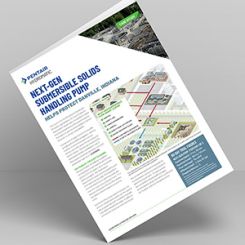Communication between the plant and the pump vendor was key to success.
Rotating Equipment Repair
06/27/2018
According to the Electric Power Research Institute (EPRI), reverse engineering is: The process of developing technical information sufficient to duplicate an item by physically examining, measuring or testing existing items, reviewing technical data or performing engineering analysis. The goal is to manufacture a new part to meet or exceed the form, fit and function of the original part. To reverse engineer a part, we need to consider:
- material of construction
- material properties (hardness and surface finish)
- geometry
- how the part was manufactured originally versus possibility of improved method
- casting
- weldment
- machined
- fit-up relative to mating component(s)
Waste Gas Compressor Lobe
A nuclear power plant needed a replacement for an obsolete part. In this case, it was a damaged lobe to a compressor that functions to remove unwanted entrained gases from reactor coolant water. A similar component was located at another site, but it was cast iron. The one needing replacement was cast bronze. Also, lead time for a new part from the original equipment manufacturer (OEM) was too long.Solution
The site contacted a pump repair company that has reverse engineering expertise. A plan was put in place to gather the data necessary to successfully manufacture a replacement lobe. Image 1. Waste gas compressor lobe (Images courtesy of Rotating Equipment Repair)
Image 1. Waste gas compressor lobe (Images courtesy of Rotating Equipment Repair) Image 2. 3D printed pattern equipment
Image 2. 3D printed pattern equipmentDilution Water Pump
A nuclear power plant was experiencing vibrations on a single stage vertical mixed flow pump. The pumps had been added to a cooling system to minimize environmental impact of an originally designed once-through cooling system. The pumps pump fresh lake water. They typically required overhaul after only 18 months of run time. The plant made efforts to understand the reasons behind the rapid wear. Vibration levels and surface vortices were thoroughly studied. These studies suggested that premature wear was due to the following: Rubbing as supported by high 1x rotational vibration levels. Rubbing was thought to be potentially due to loose or nonconcentric stationary fits. Operation away from best efficiency point (BEP) was supported by evidence of cavitation erosion on the impeller vanes. The pump was thought to have a head curve with a relatively flat rise, which would make operation away from BEP have potentially excessive implications. Image 3. Finished lobe
Image 3. Finished lobe Image 4. Deviation report
Image 4. Deviation report Image 5. Damage to vane
Image 5. Damage to vane - The impeller vanes were excessively worn on their edges. Significant erosion damage was observed on one vane only (See Image 5).
- The shaft sleeve that ran just above the impeller was worn severely on one side only (See Image 6).
- The fits were marginally loose between stationary components, but not enough to suggest amount of wear seen.
- The total indicated runout (TIR) shafts did not exhibit more than six-thousandths of an inch—not great but not enough to suggest amount of wear seen.
 Image 6. Worn shaft sleeve
Image 6. Worn shaft sleeve
